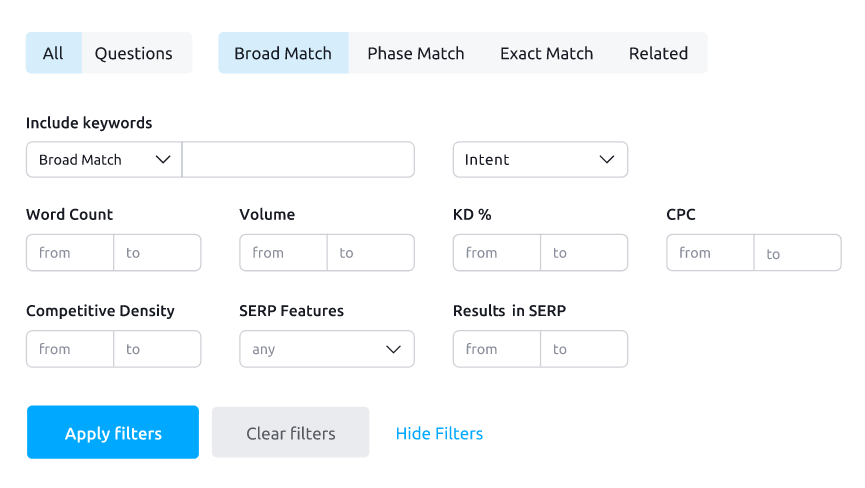You’ve spent countless hours creating content for your website, but despite your efforts, your pages aren’t ranking as high as you’d like in search results. The root of the problem might be the lack of a strategic approach to keyword organization.
Without a proper keyword mapping strategy, your content can easily become disorganized, leading to keyword cannibalization and missed opportunities for ranking.
The solution lies in keyword mapping—a method that involves assigning specific keywords to each page of your website, ensuring that your content is strategically organized to rank better.
By creating a keyword map, you can clearly define which keywords belong to which pages, avoid duplication, and ensure that each piece of content has a clear purpose.
Ready to take your SEO strategy to the next level? Learn the basics of keyword mapping, discover its benefits, and follow our step-by-step guide to create your own keyword map.
Table of Contents
What is Keyword Mapping and Why It Matters
Keyword mapping is a process that organizes keywords effectively for SEO, creating a structured roadmap for your website content.
Think of it as the backbone of an optimized SEO strategy, where each keyword is meticulously assigned to a specific page.
This method, known as SEO keyword mapping, ensures that your site is not only well-organized but also primed to rank higher on search engines.
The importance of keyword mapping lies in its ability to enhance user experience and improve search rankings by creating an intuitive site structure.
Creating a detailed keyword map involves grouping relevant target keywords and assigning them to landing pages. This approach helps track keyword volume, difficulty, and other metrics, allowing you to focus your SEO efforts where they matter most.
Benefits of Keyword Mapping for SEO
Keyword mapping offers numerous benefits that can significantly enhance your SEO strategy.
By structuring content and ensuring each page targets relevant keywords, keyword mapping directly improves SEO performance. This process not only prevents keyword cannibalization but also enhances internal linking and aligns content with search intent.
Each of these benefits plays a crucial role in optimizing your website for search engines and improving user experience.
Prevents Keyword Cannibalization
Your website has multiple pages, but none of them seem to rank well for specific keywords. This might be because they’re all targeting the same search terms, causing keyword cannibalization—a situation where your own content competes against itself.
When several pages on your site target the same keyword, search engines like Google struggle to determine which page should rank highest. Instead of boosting your visibility, this internal competition dilutes your SEO efforts, leaving you with several underperforming pages. Imagine missing out on higher rankings simply because your content isn’t strategically organized, and as a result, potential customers are slipping through the cracks.
By implementing proper keyword mapping, you assign distinct keywords to each page, effectively eliminating keyword cannibalization. This strategic approach ensures that every page has a unique focus, allowing search engines to clearly identify the most relevant page for each search query.
As a result, your site’s ranking potential improves, and your content is more likely to reach the audience you’re targeting.
Enhances Internal Linking
When internal links are scattered and unorganized, users struggle to find relevant information, leading to higher bounce rates and lower engagement.
Additionally, search engines may have difficulty determining the hierarchy and relevance of your pages, which can result in poor indexing and lower search rankings.
This disjointed linking approach dilutes your site’s authority, as link equity isn’t efficiently distributed, preventing key pages from gaining the visibility they deserve.
Ultimately, your efforts to attract and retain visitors are undermined by a weak internal linking strategy.
Keyword mapping provides a strategic approach to enhancing your internal linking by assigning specific keywords to each page. This ensures that links are created between topically related pages, fostering a well-organized site structure.
Aligns Content with Search Intent
Your website’s content may be well-written, but if it doesn’t align with what users are actually searching for, it can miss the mark.
Misalignment between your content and search intent can cause your pages to rank lower in search results, as search engines prioritize content that directly addresses users’ needs.
Keyword mapping offers a strategic solution by aligning your content with the specific intent behind search queries.
By carefully matching relevant keywords to the pages that best satisfy user intent, you can create content that directly addresses what users are searching for. This often involves targeting long-tail keywords, which are more specific, have higher user intent, and face less competition.
Steps to Create an Effective Keyword Map
A systematic approach is key to creating an effective keyword map. Begin with thorough keyword research, then group keywords into clusters, and finally assign them to relevant pages.
These steps help form a coherent website structure, facilitating search engines in identifying important pages and enhancing on-page optimization.
Conduct Thorough Keyword Research
Keyword research is fundamental to an effective keyword map.
Tools like Google Keyword Planner and SEMrush can help discover new keywords and assess their competition. Identifying ranking keywords and understanding their estimated monthly search volume will guide your content strategy, ensuring alignment with effective SEO practices.
Group Keywords into Clusters
Keyword clustering involves organizing keywords with similar search intent into groups or clusters. This method helps prevent redundancy and ensures that your content is optimized for a broader range of related primary keyword ideas and search queries.
Organizing keywords into topic clusters creates a logical site structure, enhancing user experience and SEO performance.
Using a spreadsheet to categorize and map keywords to specific pages can further streamline this process.
Assign Keywords to Relevant Pages
Assigning keywords to relevant pages is the final step in creating an effective keyword map.
Analyze the search intent behind each keyword and map it to the page that best satisfies that intent. If no existing page meets the search intent, create new content that does.
Regularly updating the status and last updated columns in your keyword map helps maintain relevance and ensures that your SEO strategy adapts to changing trends.
We live, breathe & Dream Paid Traffic
Tools for Keyword Mapping ⚙️
Using the right tools and templates can significantly enhance the efficiency of your keyword mapping process.
Tools like HubSpot’s topic clusters and Google Search Console, along with downloadable templates, simplify the task of organizing and assigning keywords.
Implementing these resources leads to better SEO outcomes and a more structured approach to content planning.
Using Google Search Console and Analytics
Google Search Console is a powerful tool for tracking the performance of specific keywords and identifying which ones are driving traffic to your site.
Using this tool alongside Google Analytics provides insights into search queries, search volume, and user behavior, which are crucial for refining your SEO efforts and keyword strategy.
These tools help you monitor the effectiveness of your keyword mapping and make data-driven decisions to enhance your site’s performance.
Recommended Keyword Mapping Tools
Several tools, such as Ahrefs’ Keywords Explorer and SEMrush, are essential for effective keyword mapping, offering a wealth of data and insights to help you refine your strategy.
With Ahrefs’ Keywords Explorer, you can begin by entering a seed keyword related to your niche. The tool generates a list of related keywords, providing key metrics like search volume, keyword difficulty, and click-through rates. You can then filter these keywords based on search intent, allowing you to focus on terms that align with your content goals—whether informational, navigational, or transactional.
Additionally, Ahrefs offers competitor analysis, enabling you to see which keywords your competitors are ranking for and assess the content they’ve created around those terms.
SEMrush offers similar powerful capabilities. By using the Keyword Magic Tool, you can generate a comprehensive list of keyword variations, including long-tail options, with detailed metrics such as search volume, trend data, and keyword difficulty.
SEMrush also allows you to monitor how your pages are ranking for the selected keywords over time through the Position Tracking feature. This real-time data helps you adjust your keyword mapping strategy as needed.
Additionally, SEMrush’s content gap tool identifies keywords that your competitors rank for but you don’t, revealing new keywords to target and map to the appropriate pages on your site.
Common Mistakes to Avoid in Keyword Mapping
While keyword mapping is essential for SEO success, there are common mistakes that can undermine its effectiveness.
Below are some of the most critical pitfalls to watch out for and how to avoid them.
Ignoring Search Intent
Ignoring search intent is one of the most critical mistakes in keyword mapping. When you overlook the specific intent behind search queries, your pages may end up competing against each other for the same keyword, leading to keyword cannibalization. This not only confuses search engines but also diminishes your site’s ranking potential.
To avoid this, it’s essential to align your keywords with the exact search intent of users. For instance, if users are searching for detailed guides, your content should provide in-depth information rather than just surface-level insights.
Overloading Pages with Keywords
Overloading pages with keywords is another common error. While it might seem like a good idea to cram as many keywords as possible into a page, this practice can actually harm both user experience and search engine rankings.
Instead of fixating on keyword density, the focus should be on crafting high-quality, relevant content that naturally incorporates keywords. Each keyword should be strategically placed to support the unique content of the page, ensuring there’s no redundancy or unnecessary repetition.
Neglecting Regular Updates
Neglecting regular updates to your keyword map is a mistake that can lead to outdated strategies and missed opportunities. The landscape of search trends and user behavior is constantly evolving, so your keyword mapping needs to be dynamic as well.
For example, if you notice a shift in popular search terms or a change in how users are finding your content, you should adjust your keyword strategy accordingly. Tools like Ahrefs and SEMrush can be invaluable for tracking page rankings and keyword performance, helping you make timely updates and optimizations.
Summary
Keyword mapping is an indispensable tool in the SEO arsenal, providing a structured approach to organizing and optimizing your website content.
The step-by-step process of conducting thorough keyword research, grouping keywords into clusters, and assigning them to relevant pages ensures that your site is well-organized and primed for success.
Utilizing tools and templates, avoiding common mistakes, and applying advanced optimization tips will keep your keyword map effective and up-to-date.
With this comprehensive guide, you’re now equipped to create an intuitive, dynamic keyword map that drives organic traffic and enhances user experience.
Start mapping your keywords today and watch your SEO efforts flourish!🌸
Frequently Asked Questions
What is keyword mapping and why is it important?
Keyword mapping is essential for optimizing SEO as it involves organizing keywords for specific pages, enhancing website structure, improving search rankings, and providing a better user experience.
How does keyword mapping prevent keyword cannibalization?
Keyword mapping prevents keyword cannibalization by assigning unique keywords to individual pages, thus avoiding internal competition.
This clarity helps search engines determine the most relevant page for specific queries, enhancing overall SEO effectiveness.
What tools are recommended for keyword mapping?
For effective keyword mapping, it’s advisable to use tools such as Ahrefs’ Keywords Explorer, SEMrush, and Google Search Console, as they offer valuable keyword data and competitive insights to enhance your strategy.
How often should I update my keyword map?
You should update your keyword map regularly to stay aligned with changing trends and user behavior. Continuous monitoring is key to maintaining its relevance and effectiveness.
What are long-tail keywords and why are they important in keyword mapping?
Long-tail keywords are specific search phrases that typically have lower competition, which allows for more targeted traffic and improved conversion rates.
Check out more blog posts:

Technical SEO: A Complete Guide to Optimizing Your Website for Search Engines







